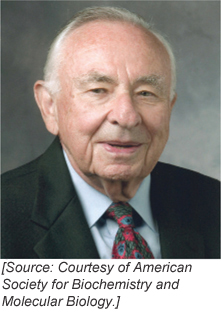Chapter Introduction
11: DNA Replication
363
MOMENT OF DISCOVERY

I started my laboratory at Stanford to study DNA recombination using the biochemical methods established by Arthur Kornberg for working with DNA polymerase. Matt Meselson’s lab at Harvard had evidence that DNA recombination involved breaking and joining of DNA strands, so we set out to find an enzyme that sealed the break by forming a phosphodiester bond.
Using E. coli cell extracts and a substrate DNA duplex with single-
We used two different enzyme nucleases to degrade the DNA. One enzyme digested DNA to mononucleotides leaving the 32P at the 5′ end; the other enzyme digested DNA in the opposite direction to give a mononucleotide with 32P at the 3′ end. If the linkage in the DNA were due to a phosphodiester bond, both of these products would be observed, depending on which nuclease was used. But if the linkage was due to a protein, neither of these would show up in the analysis, and we would have seen 32P attached to a protein instead. I’ll never forget the electric moment when my students and I looked at the two chromatograms used to analyze the DNA degradation products, and there they were staring right at us—
—Robert Lehman, on discovering DNA ligase
364
Having covered the properties of DNA, RNA, and protein—
This chapter focuses on the process of DNA replication—the duplication of the cellular genome, in which the stored genomic information is handed down to the next generation. DNA replication is central to life and to evolution; without it, there could be no transfer of information across generations. Any modifications to the genome that help or hurt the organism would be lost instead of inherited by its offspring. DNA replication is also highly regulated in response to the environment. Replication should occur only when the cell has sufficient resources to divide and form two new cells. In multicellular organisms, loss of control over this process leads to cancer—
The structure of DNA is so elegant and simple that one might think the process of duplicating DNA would reflect this simplicity. But the replication of DNA is far from simple. Imagine the evolutionary pressure to develop robust enzymatic machinery that duplicates this large set of instructions with the high fidelity imperative to maintaining the species. The accuracy of replication is particularly crucial because even a seemingly low error rate of one incorrect base pair in a thousand would produce three million mutations after a single replication cycle of the DNA in a human cell! As we will see, this evolutionary pressure has resulted in novel enzymatic architectures working in ways that are beautiful to behold. The interplay of numerous replication proteins follows a complex choreography to produce two identical DNA molecules from one.
The principles of DNA replication are surprisingly similar in bacteria, archaea, and eukaryotes alike. We begin the chapter with some classic studies that provide an overview of the replication process, and then take a look at the chemistry of the reaction, the structure of DNA polymerase (the enzyme that joins nucleotides into a DNA chain), and the many other proteins needed to replicate double-